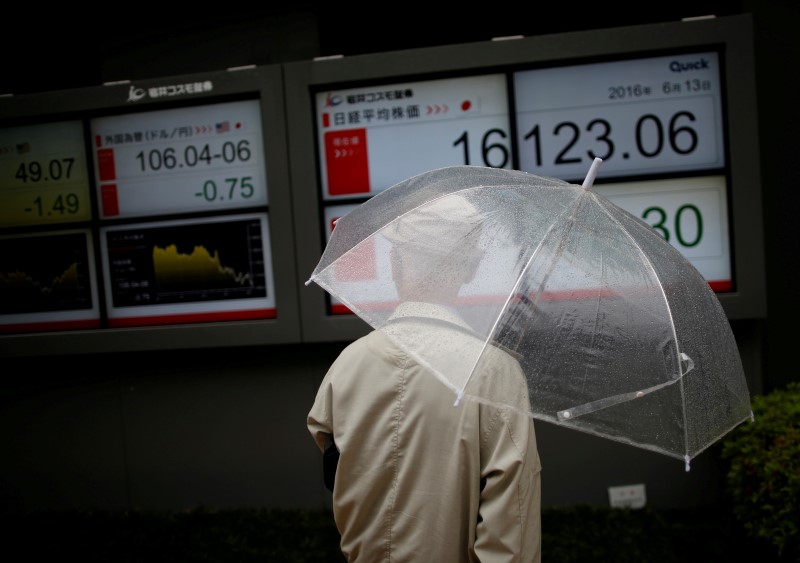By Jamie McGeever
LONDON (Reuters) - The yen jumped on Friday and the biggest rise in Japanese government bond yields in years lifted sovereign borrowing costs around the world, after the Bank of Japan's latest measures to boost growth and inflation fell short of investor expectations.
Investors also digested a heavy slew of European corporate earnings dominated by some of the region's biggest banks and awaited the first estimate of second-quarter U.S. growth.
The dollar's fall against the yen, its steepest in a month and fourth steepest this year, pulled it down against other currencies, putting the trade-weighted dollar exchange rate on course for its biggest weekly fall in two months.
Stocks absorbed the BOJ's decision a little more easily, in part because the central bank increased the purchases of exchange-traded funds (ETFs) in its easing package. Japan's Nikkei rose, and European indices rose on the back of better-than-expected results from Barclays (L:BARC) and UBS (S:UBSG).
"That the BOJ did not increase bond purchases is significant and will disappoint those looking for coordination of monetary and fiscal easing," said Adam Cole, head of currency strategy at RBC Capital Markets.
"While the increase in ETF purchases is helpful, it still makes up a very small part of the overall easing package," Cole said, noting that the BOJ has left the door open to more easing but will be unable to prevent the yen from rallying further.
The BOJ modestly increased purchases of ETFs, but maintained its base money target at 80 trillion yen ($775 billion) and the pace of purchases of other assets, including Japanese government bonds.
The central bank also held at 0.1 percent the interest it charges to a portion of excess reserves financial institutions leave with the central bank.
The dollar fell 1.8 percent to 103.35 yen
The dollar index fell 0.4 percent to 96.33 (DXY), while the euro inched up 0.2 percent to just under $1.11
Japan's 10-year bond yield soared 10 basis points to -0.17 percent (JP10YT=RR), on course for its biggest one-day rise since April 2008.
BANKS RISE
Japan's Nikkei (N225), which swung in and out of the red after the announcement, closed up 0.56 percent at 16,569 points. The index, which touched a seven-week high last week, rose 6.4 percent in July, its best month since October last year.
MSCI's broadest index of Asia-Pacific shares outside Japan (MIAPJ0000PUS) fell 0.64 percent, sliding back from its highest level since Aug. 11 struck earlier in the day.
The leading index of 300 European shares (FTEU3) rose 0.4 percent to 1,244 points, and Germany's DAX (GDAXI) also rose 0.4 percent.
Financials led the way, with the euro zone banking index up more than 2 percent (SX7E) and on track for a rise of nearly 8 percent for July, its best month since February.
Barclays shares were up 5 percent even though first-half profits fell 21 percent, and UBS shares were up 3 percent despite a 14.5 percent fall in second-quarter profit. Both sets of results were not as bleak as investors had feared.
Investors awaited the release of the stress test results on European banks on Friday night.
Wall Street shares remained near all-time highs, with tech heavyweights Alphabet (O:GOOGL) and Amazon (O:AMZN) rising after the bell as their earnings beat expectations.
Futures pointed to a fall of around 0.2 percent at the open on Wall Street on Friday. (ESc1) just before the first estimate of Q2 U.S. gross domestic product is released.
Economists expect a rebound to 2.6 percent from 1.1 percent in the first quarter, although the closely-watched Atlanta Fed's GDP Now tracking estimate was slashed on Thursday to 1.8 percent from 2.3 percent. [ECONUS]
"Although we continue to look for equipment spending to remain soft in 2Q, real consumption should show a solid rebound," Societe Generale (PA:SOGN) economists wrote in a note to clients.
The 10-year U.S. Treasury yield rose two basis points to 1.53 percent (US10YT=RR),
Elsewhere in markets, oil prices fell to three-month lows, with the U.S. benchmark now down more than 20 percent from this year's peak on growing worries that the world might be pumping more crude than needed.

U.S. crude futures fell to as low as $40.75 per barrel (CLc1) and were last down 0.9 percent at $40.77. Brent crude futures (LCOc1) dropped 1.1 percent to $42.22. It is down 7.6 percent this week and 15 percent this month.